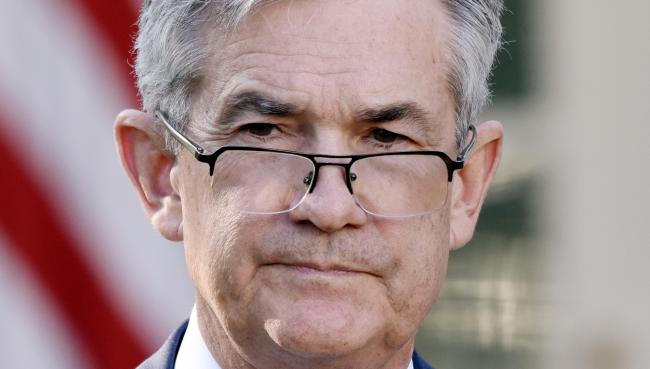(Bloomberg) -- The hunt is on for Jerome Powell’s dots.
The dots represent where the Federal Reserve governor projects interest rates will go over the next three years. Every quarter he and fellow U.S. central bankers submit their forecasts, which the Fed lays out in the form of dots on a graph with no names attached. Publication of the so-called dot plot sparks an obsessive game of elimination among economists, investors and journalists who try to identify the author of each rate call.
But not all the dots are considered equal. Powell is now President Donald Trump’s nominee for Fed chairman, which changes what sleuths think about his projections -- if they can find them.
“Powell’s dots now become significantly more important than anyone else’s at the Fed,” said John Silvia, chief economist at Wells Fargo (NYSE:WFC) Securities. “You know what they say about sled dogs: Unless you’re in front, the view never changes.”
So how fast, exactly, does Powell think the central bank will lift its benchmark interest rate?
Read about Powell’s nomination process to run the Fed.
For the latest dot plot, published in September, it isn’t difficult to guess Powell’s 2017 forecast. Eleven of 16 Federal Open Market Committee members said one more quarter-point hike would be appropriate this year, which would lift the target range for the federal funds rate to 1.25 percent to 1.5 percent. Powell’s repeated support for what he calls “gradual policy normalization” puts him solidly in that group of 11.
Things get more interesting at the end of 2018, when six officials are clustered at 2 percent to 2.25 percent, including the median dot. Five dots lie above the median, and five below.
‘More Muted’
The five lower dots are fairly easy to assign. St. Louis Fed President James Bullard has said rates should stay where they are for another two to three years. The next most clearly dovish officials are Chicago chief Charles Evans and Governor Lael Brainard, both of whom have expressed concern about low inflation, plus Minneapolis President Neel Kashkari, who dissented twice in 2017 when the committee raised rates.
Next is Dallas President Robert Kaplan, who said last month his forecast for rate increases in 2018 is “a little more muted” than the median. While not definitive, those remarks make him the best candidate for the fifth dovish dot.
Of the five dots sitting above the median cluster, four are giveaways. Esther George of Kansas City, Cleveland’s Loretta Mester and Boston’s Eric Rosengren all dissented at least once in favor of hikes in 2016 when the Fed held off from tightening until December.
Another safe hawk bet is Mark Mullinix, first vice president for the Richmond Fed, who is temporarily filling that seat as that regional bank searches for a new president. Mullinix is probably submitting projections crafted by Richmond’s research department, which has a reputation for hawkishness.
‘Gradual’ Tightening
From there, seven 2018 dots remain, all of which probably belong to officials who landed at 1.25 percent to 1.5 percent at the end of 2017. That means six of them called for three hikes in 2018, and one projected four. Powell’s professed preference for “gradual” tightening could reasonably describe either number.
Among those, only Philadelphia’s Patrick Harker has outed himself, saying Nov. 7 he favored three moves next year.
Gauged by their public comments, it’s hard to determine who of those left -- Raphael Bostic of Atlanta, New York’s William Dudley, San Francisco’s John Williams, the now-retired former Vice Chairman Stanley Fischer, the current chair Janet Yellen or Powell -- might be the last four-hike dot.
If it’s Powell, that would signal a bias toward a somewhat steeper path of rate hikes compared with the current center of the committee.
“That would be significant,” said Omair Sharif, senior U.S. economist at Societe Generale (PA:SOGN) SA. “We’re not priced for that. The market would certainly get more nervous.”
Investor Bet
Investors are betting on one or two rate increases in 2018, based on pricing in fed funds futures contracts. It’s more likely, Sharif said, that Powell is a three-hike dot in 2018, a view backed by Silvia and Joseph Song, senior U.S. economist at Bank of America Corp (NYSE:BAC).
“We always felt Powell was within the core members of the FOMC,” Song said. “They all have their little tilts, but we felt he was in the big clump of dots for 2017 and 2018.”
Guessing Powell’s dot another year out gets more perilous. In 2019, it’s possible to assign five or six of the lowest projections to other central bankers, as well as the three highest. But even after eliminating those, the center of the committee is no longer as clustered as it is for 2018. Powell could easily fall anywhere from just above 2.5 percent to just below 3.25 percent, a range that encompasses significantly different views on where monetary policy is headed.
“You could drive a truck through that,” Sharif said.
Guessing Powell’s 2019 dot is especially problematic given that in five-plus years at the Fed, his public comments have closely reflected the policies of his chairs, Ben Bernanke and Yellen. It’s unclear where his own views lie on deep economic questions that might determine where rates will go in the medium-term.
Lee Ferridge, North American head of cross-asset strategy for State Street Corp (NYSE:STT)., has a more contrarian view. He says the Powell dot hunt may be a fruitless exercise.
“I don’t think he’s got strong views on the course of monetary policy,” Ferridge said. “He’s not a Ph.D. He’s got no strong theoretical views on the economy to fall back on. I think he’ll gauge the consensus in the room and go with that.”
